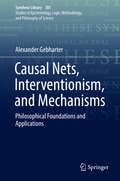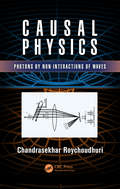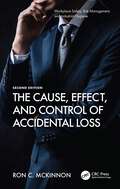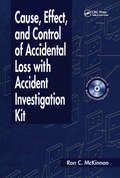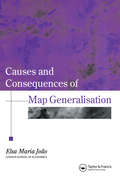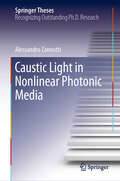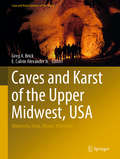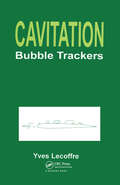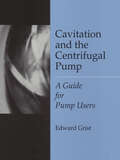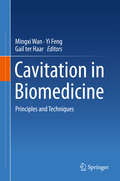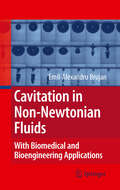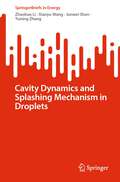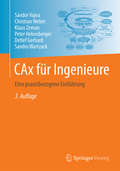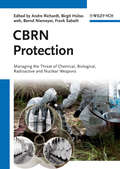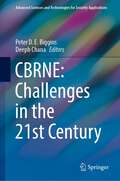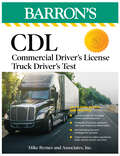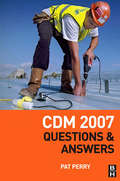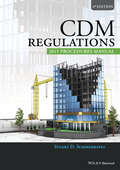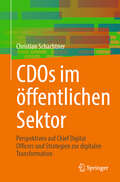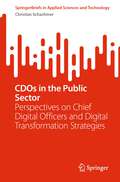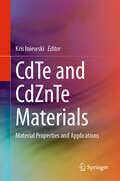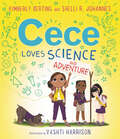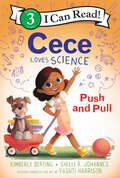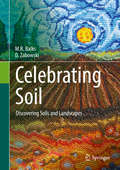- Table View
- List View
Causal Nets, Interventionism, and Mechanisms: Philosophical Foundations and Applications (Synthese Library #381)
by Alexander GebharterThis monograph looks at causal nets from a philosophical point of view. The author shows that one can build a general philosophical theory of causation on the basis of the causal nets framework that can be fruitfully used to shed new light on philosophical issues. Coverage includes both a theoretical as well as application-oriented approach to the subject. The author first counters David Hume's challenge about whether causation is something ontologically real. The idea behind this is that good metaphysical concepts should behave analogously to good theoretical concepts in scientific theories. In the process, the author offers support for the theory of causal nets as indeed being a correct theory of causation. Next, the book offers an application-oriented approach to the subject. The author shows that causal nets can investigate philosophical issues related to causation. He does this by means of two exemplary applications. The first consists of an evaluation of Jim Woodward's interventionist theory of causation. The second offers a contribution to the new mechanist debate. Introductory chapters outline all the formal basics required. This helps make the book useful for those who are not familiar with causal nets, but interested in causation or in tools for the investigation of philosophical issues related to causation.
Causal Physics: Photons by Non-Interactions of Waves
by Chandrasekhar RoychoudhuriCausal Physics: Photons by Non Interactions of Waves redefines the mathematical Superposition Principle as an operational Superposition Effect; which is the measurable physical transformation experienced by a detector due to stimulations induced by multiple waves simultaneously acting on the detecting dipoles. This light-matter interaction process driven model emerges naturally by incorporating the observed properties, Non-Interaction of Waves (NIW) and quantized photo detectors needing to fill up their "quantum-cups" with the required quantity of energy from all the stimulating waves around it. By not incorporating this NIW-property explicitly, quantum mechanics failed to extract various embedded realities in the theory while incorporated unnecessary hypotheses like wave-particle duality. The book utilizes this NIW-property to explain all the major optical phenomena (diffraction, spectrometry, coherence.) without using any self-contradictory hypotheses that are prevalent now. The book redefines the old ether (constituting the space) as a stationary Complex Tension Field (CTF), holding all the energy of the universe (no need for Dark Energy of Dark Matter). CTF sustains perpetually propagating EM waves as its linear excitations and the particles as self-looped localized resonant non-linear excitations. Tensions are identified by Maxwell, then the velocities of emitting and detecting atoms through the CTF contribute to the Doppler shifts separately. This calls for re-visiting physical processes behind Hubble Redshift and hence Expanding Universe. The success of the book derives from a novel thinking strategy of visualizing the invisible interaction processes, named as Interaction Process Mapping Epistemology (IPM-E). This is over and above the prevailing strategy of Measurable Data Modeling Epistemology (MDM-E). The approach inspires the next generation of physicists to recognizing that the "foundation of the edifice of physics" has not yet been finalized. IPM-E will stimulate more of us to become technology innovators by learning to emulate the ontologically real physical processes in nature and become more evolution congruent. Critical thinkers without expertise in optical science and engineering, will appreciate the value of the content by reading the book backward, starting from Ch.12; which explains the critical thinking methodology besides giving a very brief summary of the contents in the previous chapters. Establishes that abandoning the wave-particle-duality actually allows us to extract more realities out of quantum mechanics. Illustrates how the discovery of the NIW-property profoundly impacts several branches of fundamental physics, including Doppler effect and hence the cosmological red shift Summarizes that many ad hoc hypotheses from physics can be removed, a la Occam’s razor, while improving the reality and comprehension of some of the current working theories Demonstrates that our persistent attempts to restore causality in physical theories will be guided by our capability to visualize the invisible light matter interaction processes that are behind the emergence of all measurable data Draws close attention to the invisible but ontological interaction processes behind various optical phenomena so we can emulate them more efficiently and knowledgably in spite of limitations of our theories Designed as a reference book for general physics and philosophy, this optical science and engineering book is an ideal resource for optical engineers, physicists, and those working with modern optical equipment and high precision instrumentation.
The Cause, Effect, and Control of Accidental Loss (Workplace Safety, Risk Management, and Industrial Hygiene)
by Ron C. McKinnonThe Cause, Effect, and Control of Accidental Loss takes the reader through 15 phases of a typical workplace accident and shows how accidents can be prevented by the introduction of safety management controls in the form of a structured health and safety management system (SMS). It proposes that once the event has been triggered, there is no certainty as to the outcome, so workplaces should rely on proactive safety actions rather than reactive ones. Now fully updated, this new edition expands on the important concepts from the first edition, including hazard identification, risk assessment, flawed safety management systems, the potential for loss, and management control. This title: • Challenges the paradigm that the measure of consequence (losses) is a good indicator of safety effort. • Introduces three luck factors that determine the course of the accident sequence. • Explains what causes accidents, their consequences, and how to prevent them. • Showcases accident immediate causes including high-risk (unsafe) acts and high-risk (unsafe) conditions. The text is an essential read for professionals, graduate students, and academics in the field of occupational health, safety, and industrial hygiene.
Cause, Effect, and Control of Accidental Loss with Accident Investigation Kit
by Ron Charles McKinnonAccident: an undesired event that results in loss. Most people give little thought to accidents or their prevention. Health and safety professionals face this challenge, and its associated costs and losses, both human and financial, every day. Cause, Effect, and Control of Accidental Loss with Accident Investigation Kit provides the tools you need
Causes And Consequences Of Map Generalization
by Elsa JoaoThis text describes late-1990s understanding of map generalisation in the context of paper maps and GIS. Its particular value should be in helping to further automate and measure the process of map generalisation.; The research has concentrated on quantifying generalisation effects and on analysing how these effects of generalisation locked into the maps were measured. Elsa Joao's book covers the background to the problems of map generlasation; the methodology developed by the author to investigate the consequences of the map generalisation; a detailed description of results, and a conclusion that draws together consequences for the broader applications to GIS.
Caustic Light in Nonlinear Photonic Media (Springer Theses)
by Alessandro ZannottiCaustics are natural phenomena, forming light patterns in rainbows or through drinking glasses, and creating light networks at the bottom of swimming pools. Only in recent years have scientists started to artificially create simple caustics with laser light. However, these realizations have already contributed to progress in advanced imaging, lithography, and micro-manipulation. In this book, Alessandro Zannotti pioneers caustics in many ways, establishing the field of artificial caustic optics. He employs caustic design to customize high-intensity laser light. This is of great relevance for laser-based machining, sensing, microscopy, and secure communication. The author also solves a long standing problem concerning the origin of rogue waves which appear naturally in the sea and can have disastrous consequences. By means of a far-reaching optical analogy, he identifies scattering of caustics in random media as the origin of rogue waves, and shows how nonlinear light-matter interaction increases their probability.
Caves and Karst of the Upper Midwest, USA: Minnesota, Iowa, Illinois, Wisconsin (Cave and Karst Systems of the World)
by Greg A. Brick E. Calvin Alexander Jr.This book discusses the karst and pseudokarst of the Upper Midwest, USA, consisting of the states of Minnesota, Wisconsin, Iowa, and Illinois—the first regional synthesis in 40 years. Starting with an overview of the regional geology of what is largely glaciated fluviokarst and paleokarst developed on Paleozoic carbonates, but including other lithologies such as the St. Peter Sandstone and the Ft. Dodge Gypsum, the caves, springs, sinkholes, and karst hydrogeology of each state are described. Special attention is devoted to the region’s longest caves: Coldwater Cave, Mystery Cave, and the Minnesota Cave Preserve caves. Application of tools such as data loggers and LiDAR, with new conceptual models such as hypogenic speleogenesis, has been transformative here. Special topics include lead and zinc mining in the Driftless Area, vertebrate and invertebrate cave fauna near the Laurentide ice limit, the impact and policies of nutrient and herbicide intensive modern agriculture on karst, and paleoclimate studies. The discovery, exploration, institutional history of caving organizations, and show caves of the Upper Midwest, from the year 1700 onwards, are brought up to date. The top 10 historical paradigms of cave and karst science in the Midwest are reviewed. Perspectives on paleontology, archeology, and Native American rock art are included.
Cavitation: Bubble Trackers
by Yves LecoffreThis text deals with the concept that cavitation is the main limitation to the performance of hydraulic components. Topics covered include the vaporization of liquids due to high velocities or pressure fluctuations, and the effects of cavitation on the performances of rotary machinery. One chapter is devoted to cavitation noise which concerns many users, including surface ships and submarines, and the author finishes with some examples of the use of cavitation and subject-specific measuring techniques.
Cavitation And The Centrifugal Pump: A Guide For Pump Users
by Edward GristThis practical reference describes the occurrence of cavitation in a centrifugal pump, and how unacceptable cavitation can be avoided. It explains cavitation problems such as hydraulic performance loss, hydrodynamically or thermodynamically induced surging, and cavitation erosion. General guidelines for acceptable operation conditions, such as, net positive suction head (NPSH) margins and minimum flowrates, are presented along with evidence and logic for these proposed guidelines.
Cavitation in Biomedicine: Principles and Techniques
by Yi Feng Mingxi Wan Gail Ter HaarThis book offers a systematic introduction to the engineering principles and techniques of cavitation in biomedicine on the basis of its physics and mechanism. Adopting an interdisciplinary approach, it covers areas of interest ranging from physics and engineering to the biological and medical sciences. Individual chapters introduce the fundamentals of cavitation, describe its characterization, control and imaging techniques, and present cavitation-enhanced thermal and mechanical effects and their applications. Intended as both a reference work for graduate students, and as a guide for scientists and engineers who work with cavitation in biomedicine, it provides a broad and solid foundation of knowledge. The aim is to bridge the different disciplines involved, and to promote cross-discipline research, thus encouraging innovations in the scientific research and engineering applications alike. Dr. Mingxi Wan is a professor at Department of Biomedical Engineering, Xi'an Jiao Tong University, Xi'an, Shaanxi, China; Dr. Yi Feng works at Department of Biomedical Engineering, Xi'an Jiao Tong University, Xi'an, Shaanxi, China; Dr. Gail ter Haar is a professor at The Institute of Cancer Research, Sutton, Surry, UK.
Cavitation in Non-Newtonian Fluids: With Biomedical and Bioengineering Applications
by Emil BrujanNon-Newtonian properties on bubble dynamics and cavitation are fundamentally different from those of Newtonian fluids. The most significant effect arises from the dramatic increase in viscosity of polymer solutions in an extensional flow, such as that generated about a spherical bubble during its growth or collapse phase. In addition, many biological fluids, such as blood, synovial fluid, and saliva, have non-Newtonian properties and can display significant viscoelastic behaviour. This monograph elucidates general aspects of bubble dynamics and cavitation in non-Newtonian fluids and applies them to the fields of biomedicine and bioengineering. In addition it presents many examples from the process industries. The field is strongly interdisciplinary and the numerous disciplines involve have and will continue to overlook and reinvent each others' work. This book helps researchers to think intuitively about the diverse physics of these systems, to attempt to bridge the various communities involved, and to convey the interest, elegance, and variety of physical phenomena that manifest themselves on the micrometer and microsecond scales.
Cavity Dynamics and Splashing Mechanism in Droplets (SpringerBriefs in Energy)
by Zhaohao Li Xiaoyu Wang Junwei Shen Yuning ZhangThis brief explores the pivotal realm of droplet cavitation, a subject of great significance for enhancing fuel atomization and improving various industrial processes. The authors employ high-speed photography experiments, analyze bubble dynamics equations, and utilize numerical simulations to explore the dynamic behavior of cavitation bubbles and droplets. The book analyzes the entire lifecycle of cavitation bubbles, their interactions with different liquid droplets, and the key parameters governing their oscillation and collapse and sheds light on the collapse mechanisms and shock wave propagation influenced by liquid droplets. Additionally, it investigates the dynamics of droplet spattering by categorizing spatter patterns under diverse conditions, discusses the critical stability of droplet surfaces, and reveals the mechanisms by which cavitation bubble collapses induce droplet breakage. Taking vapor bubbles and diesel droplets as examples, the dynamic characteristics of specific droplets containing bubbles are also analyzed. This book offers an in-depth understanding of these phenomena with practical implications for a wide range of industrial applications and is a useful tool for researchers and engineers working in the fields of fluid dynamics, combustion engineering, and atomization processes.
CAx für Ingenieure: Eine praxisbezogene Einführung
by Sandro Wartzack Detlef Gerhard Peter Hehenberger Klaus Zeman Christian Weber Sándor VajnaDieses nun in der dritten Auflage erschienene Buch vermittelt die Grundlagen des systematischen Einsatzes von rechnerunterstützten Methoden, Vorgehensweisen und Werkzeugen in der Produktentstehung. Es bietet seinen Zielgruppen in knapper und übersichtlicher Form das Rüstzeug für die erfolgreiche Anwendung von CAx-Systemen. Vorgehensweisen und Beispiele basieren auf Erfahrungen in Industrie und Hochschulpraxis, wo sie ihre Effizienz bewiesen haben.Die 3. Auflage wurde gründlich überarbeitet, der Kreis der Autoren erweitert. So kamen nicht nur Aspekte unterschiedlicher Modellierungsarten, Mechatronik und Wissensverarbeitung hinzu, sondern auch Ausführungen zu Systembegriff und Modellaufbau (diese bilden die Basis für CAx-Anwendungen). Sie alle beeinflussen immer stärker die Fertigungstechnik und den modernen Fahrzeug-, Maschinen- und Anlagenbau und sie spannen den Bogen zur Systemtechnik. Neben dem aktuellen und zukünftigen Leistungsstand von CAx-Systemen wurden auch Richtlinien und Empfehlungen zum Stand der Technik berücksichtigt.ZielgruppenDas Buch eignet sich für Studierende der Ingenieurwissenschaften, für Fachleute in Unternehmen sowie für Führungskräfte, die über Einsatz und Ausbau von CAx-Anwendungen entscheiden.
CBRN Protection
by Frank Sabath Andre Richardt Bernd Niemeyer Birgit HülsewehOriginating in the armed forces of the early 20th century, weapons based on chemical, biological or nuclear agents have become an everpresent threat that has not vanished after the end of the cold war. Since the technology to produce these agents is nowadays available tomany countries and organizations, including those with terrorist aims, civil authorities across the world need to prepare against incidents involving these agents and train their personnel accordingly.As an introductory text on NBC CBRN weapons and agents, this book leads the reader from the scientific basics to the current threats and strategies to prepare against them. After an introductory part on the history of NBC CBRN weapons and their international control, the three classes of nuclear/radiological, biological, and chemical weapons are introduced, focusing on agents and delivery vehicles. Current methodsfor the rapid detection of NBC CBRN agents are introduced, and the principles of physical protection of humans and structures are explained.The final parts addresses more general issues of risk management, preparedness and response management, as the set of tools that authorities and civil services will be needed in a future CBRN scenario as well as the likely future scenarios that authorities and civil services will be faced with in the coming years.This book is a must-have for Health Officers, Public Health Agencies, and Military Authorities.
CBRNE: Challenges in the 21st Century (Advanced Sciences and Technologies for Security Applications)
by Peter D. E. Biggins Deeph ChanaThis book addresses the pertinent issues that will need to be considered by those interested in physical security problems of the future. Specifically, it examines how changes in the accessibility of technology – data, hardware, software – are likely to affect both threat and mitigation considerations for Chemical, Biological, Radiological and Explosive (CBRE) scenarios and how social science can inform us of the human aspects of each. The trend towards an ever more socio-technical society and infrastructures – encapsulated by concepts such as 'smart cities' – is drawn out as a key motivation for adopting more holistic risk approaches to such security problems, than is currently the case.
CDL: Commercial Driver's License Truck Driver's Test, Fifth Edition: Comprehensive Subject Review + Practice (Barron's Test Prep)
by Mike Byrnes and Associates,Be prepared for exam day with Barron&’s. Trusted content from CDL experts!Barron&’s CDL: Commercial Driver&’s License Truck Driver&’s Test includes in-depth content review and practice. It&’s the only book you&’ll need to be prepared for exam day.Written by Experienced EducatorsLearn from Barron&’s--all content is written and reviewed by CDL expertsBuild your understanding with comprehensive review tailored to the most recent written and driving testsGet a leg up with tips, strategies, and study advice for exam day--it&’s like having a trusted tutor by your sideBe Confident on Exam DaySharpen your test-taking skills with 2 sample Knowledge Tests, a diagnostic test for assessing strengths and areas for improvement, and practice for the Skills TestStrengthen your knowledge with in-depth review covering all topics CDL drivers need to know, including federal motor carrier safety regulations, basic vehicle control, vehicle inspection, and much moreReinforce your learning with hundreds of practice questions covering all tested topicsDeepen your understanding with expert advice about commercial driver licensing, dozens of detailed diagrams that demonstrate proper driving procedures, and a series of appendices with state-specific transportation resources
CDM 2007
by Pat PerryThe Construction (Design and Management) Regulations 2007 repeal the CDM Regulations 1994 and the Construction (Health, Safety and Welfare) Regulations 1996; containing all the legal duties regarding the design and management of a construction project and the safe operating standards expected on a construction site. CDM 2007: Questions and Answers by Pat Perry is a pragmatic, common-sense approach to interpreting the many queries which will inevitably arise from the new Regulations, no matter how simplified they purport to be. The author details practical solutions to a wide range of legal compliance issues and explores answers which go beyond the rather limited information contained in the Approved Code of Practice which supports the Regulations. The various duty holders, project stages and safety issues are dealt with in different chapters and the book can be used for detailed reference or for a quick refresher on specific subjects.
CDM 2015: A Practical Guide for Architects and Designers
by Paul BusseyThis is the designer’s essential guide to implementing the new CDM 2015 regulations. It provides both a straightforward overview of the key changes and new duty holders, including the Principal Designer, as well as full colour diagrams and annotated plans which demonstrate how to apply the principles in the real world. As the regulations come into force it aims to reassure those fearing a change in their obligations by outlining easy to use practical tools which will integrate the philosophy of the new regulations – of proportionate response, creative solutions and collaborative working – into day-to-day practice. It’s designed as a concise and handy quick reference guide, easy to carry around on site or use at your desk, translating what can be dry and often impenetrable legislation into a set of simple, intuitive, design friendly and safe messages.
CDM Regulations 2015 Procedures Manual
by Stuart D. SummerhayesThe CDM Regulations require all those involved in construction to adopt an integrated approach to health and safety management. This Procedures Manual provides a documentation system for compliance with the statutory requirements. It is being thoroughly revised to take account of major changes to the CDM Regulations 2015.
CDOs im öffentlichen Sektor: Perspektiven auf Chief Digital Officers und Strategien zur digitalen Transformation
by Christian SchachtnerDieses Buch untersucht die Notwendigkeit innovativer Ansätze zur Administrationsdigitalisierung, indem Technologien wie KI, Blockchain und intelligente Prozesse genutzt werden, um den Erwartungen der Bürger gerecht zu werden. Besonderes Augenmerk liegt auf der Rolle der Chief Digital Officers (CDOs) bei der erfolgreichen digitalen Transformation innerhalb öffentlicher Institutionen. Die digitale Verwaltung erfordert frische Impulse, um mit den Fortschritten im Industriesektor Schritt zu halten, indem Technologien wie KI-gesteuerte Automatisierung, Blockchain-Transaktionen und Sicherheitswerkzeuge eingesetzt werden. Intelligente Prozesslösungen werden als transformativ angesehen, um die Service-Standards gemäß den Erwartungen der Bürger an den Staat aufrechtzuerhalten. Im Gegensatz zu kommerziellen Unternehmen bietet die Zusammenarbeit denjenigen, die die Digitalisierung im öffentlichen Sektor überwachen, erweiterte Skalierungsmöglichkeiten, indem sie auf Erfahrungen aus anderen Regionen und Metropolen zurückgreifen, die direkt anwendbar und wiederverwendbar sind. Im öffentlichen Bereich spiegeln digitale Strategien rechtliche und soziale Bedingungen wider, was Anpassungen und Anpassungsoptionen für Chief Digital Officers erforderlich macht, während sie die digitale Transformation leiten. Methodische Schwerpunkte in der Neugestaltung von Aufgabenstrukturen, Prozessoptimierung und der Motivation von Akteuren ergeben vielfältige Handlungsfelder für die neue Rolle des CDO in öffentlichen Institutionen. Dieses Buch untersucht die Instrumente, Strategien und Einstellungen, die notwendig sind, um transformative Initiativen in Organisationen erfolgreich umzusetzen, und betont bewährte Konzepte mit praktischer Anwendbarkeit, die es den Lesern ermöglichen, ihre eigenen Interaktionsmöglichkeiten als digitale Führungspersönlichkeiten abzuleiten. Das Buch ist eine prägnante Einführung in die spezifischen Anforderungen an visionäre Gestalter, die dynamische Veränderungen in nutzerzentrierten öffentlichen Dienstleistungen vorantreiben.
CDOs in the Public Sector: Perspectives on Chief Digital Officers and Digital Transformation Strategies (SpringerBriefs in Applied Sciences and Technology)
by Christian SchachtnerThis book explores the need for innovative approaches to administrative digitization, leveraging technologies such as AI, blockchain, and smart processes to meet citizens' expectations, with a particular focus on the role of Chief Digital Officers (CDOs) in driving successful digital transformations within public institutions. Administrative digitization requires fresh inputs to match the leaps seen in the industry sector, utilizing technologies like AI-driven automation, blockchain transactions, and security tools. Smart process solutions are seen as transformative in upholding service standards aligned with citizens' state expectations. Unlike commercial companies, collaboration offers those overseeing public sector digitization enhanced scaling opportunities by drawing from experiences in other regions and metropolises, directly applicable and reusable. In the public realm, digital strategies mirror legal and social conditions, necessitating adjustments and adaptation options for Chief Digital Officers as they lead digital transformation. Methodological focal points in task structure redesign, process optimization, and motivating actors yield diverse action areas for the CDO's new role in public institutions. This book explores the instruments, strategies, and attitudes necessary to successfully implement transformative initiatives in organizations, emphasizing proven concepts with practical applicability, enabling readers to derive their own interaction options as digital guidance leaders. The book is a concise introduction to the specific requirements for visionary designers driving dynamic changes in user-centric public services.
CdTe and CdZnTe Materials: Material Properties and Applications
by Kris IniewskiThis book provides readers with a good overview of some of most recent advances in the field of CdTe and CdZnTe detector technology for medical imaging, industrial testing and security scanning, especially as it pertains to new applications. There will be a good mixture of general chapters in both technology and applications inthe X-ray testing. The book will have an in-depth review of the research topics from leading world specialists in the field. The conversion of the X-ray and gamma-ray signal into analogue/digital value will be covered in some chapters. Some would also provide a review of CMOS chips for CdTe and CdZnTe image sensors. This book serves as an excellent reference for people already working in the field as well as for people wishing to enter it.
Cece Loves Science and Adventure (Cece Loves Science #2)
by Kimberly Derting Shelli R. Johannes“Smart girls, friendship, and fun: a winning combination.” —Kirkus“A wonderful book.” —School Library JournalCece loves science and adventure!In this STEM-themed Girls in Science picture book, Cece and her Adventure Girls troop use science, technology, engineering, and math to solve problems and earn their camping pin. Illustrated by New York Times–bestseller Vashti Harrison, Cece Loves Science and Adventure is perfect for fans of Ada Twist, Scientist and anyone who enjoys asking questions and figuring out how things work. Cece loves being an Adventure Girl almost as much as she loves science, which is why she can’t wait for her troop’s camping trip. Nature is full of science for Cece to explore!Along with her friends, her mom, and her dog, Einstein, Cece learns how to pitch a tent, set up a campsite, and document landmarks on the trail. Then thunder booms in the distance! Working together, the girls use meteorology and math to determine the location of the storm; engineering to build a shelter; and technology and math to calculate the length of the trek back to the campsite. After all that teamwork, Cece’s mom gives them an Adventure Girl surprise!Illustrated by Vashti Harrison, author and illustrator of the New York Times–bestselling Little Leaders: Bold Women in Black History, Cece Loves Science and Adventure is just right for curious kids and anyone who loves to explore the great outdoors. Includes a glossary.
Cece Loves Science: Push and Pull (I Can Read Level 3)
by Kimberly Derting Shelli R. JohannesCece loves science! In this STEM-themed Level 3 I Can Read! title, Cece and her friend Isaac learn about the opposite forces of push and pull, and use their new knowledge to create a treat dispenser for Cece’s dog, Einstein. Perfect for aspiring scientists, emerging readers, and fans of Andrea Beaty’s Ada Twist, Scientist. Cece loves science—and experimenting! In this Cece Loves Science Level 3 I Can Read!, Cece’s teacher, Miss Curie, explains the opposite forces of push and pull. To demonstrate this concept, she divides the class into two teams. Each team must make a treat dispenser for Cece’s dog, Einstein, that uses both forces. Cece and her classmates rely on science, creativity, and teamwork—and they learn a lot along the way. The Cece Loves Science books introduce readers to basic concepts of science, technology, engineering, and math, and are perfect for the classroom. This Level 3 I Can Read! focuses on basic scientific vocabulary and includes a glossary of terms and fun activities for readers to try on their own. A great pick for beginning readers!
Celebrating Soil: Discovering Soils and Landscapes
by M. R. Balks D. ZabowskiThis richly illustrated book celebrates the diversity, importance, and intrinsic beauty of soils around the world and helps the reader to understand the ways that soils are related to the landscapes in which they form. The book unravels the complex bond between humans and soils and the importance of soils in our cultures and everyday lives. Soil is critical to terrestrial life on earth. It underpins human food supply and provides materials on which we build our lives. Soil is out of sight and often out of mind, thus easy to overlook. Yet soil has tremendous variety and intrinsic beauty for those who care to look. Soil contains a memory of the events that have shaped the landscape and the environment. With help you can look at a soil and understand the stories that it has to tell. Written in a reader-friendly way, Celebrating Soil is a wonderful resource for farmers, horticulturalists, naturalists, students and others who are concerned about how soils are formed, work and are used.
